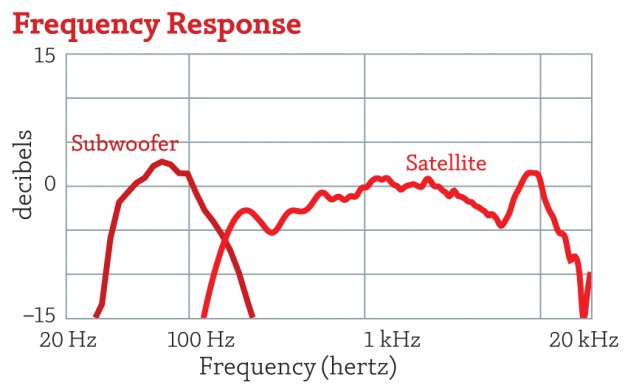Test Report: Cambridge Audio Minx 215 System Page 3
Extended Test Bench

Frequency response (at 1 meter)
• satellite 166 Hz to 20 kHz ±8.6 dB
• subwoofer 38 to 130 kHz ±3 dB
Sensitivity (SPL at 1 meter with 2.8 volts of pink-noise input)
• satellite 90 dB
Impedance (minimum/nominal)
• satellite 5.3/9 ohms
Bass output, subwoofer (CEA-2010 standard)
• Ultra-low bass (20-31.5 Hz): NA
• Low bass (40-63 Hz): 90.5 dB
Bass limits, satellite
• 100 Hz at 65.3 dB
I measured the Min10 satellite speaker at 1 meter, far enough in this case to incorporate the effects of cabinet diffraction. The speaker sat atop a 6-foot stand to give quasi-anechoic results down to 220 Hz. The curve in the graph shows an averaged response from 0° to 30°, smoothed to 1/12th of an octave. I close-miked the driver to get its bass response, then spliced that result to the averaged quasi-anechoic response to produce the curve you see here. To measure the subwoofer’s frequency response, I close-miked its active woofer and passive radiators, then summed their responses. The satellite response is normalized to 0 dB at 1 kHz, the subwoofer normalized so that its peak response shows as +3 dB.
With a measured response variance of ±8.6 dB and a wheezy –3-dB bass response of just 166 Hz, the Min10 doesn’t seem impressive at first glance. But take a closer look at that midrange. Between 375 Hz and 4.9 kHz, the response measures ±2.2 dB. Very few speakers at any price can beat that result. The seemingly uneven full-range measurement is mostly the result of plunging treble response above 12 kHz. Off-axis response is fantastic, with no response anomalies and a predictably smooth treble rolloff; basically, this thing has the dispersion of a big tweeter. To my shock, I was able to measure some bass response all the way down to 100 Hz, but it was barely there.
The Min10’s high 90-dB sensitivity and mild 9-ohm nominal impedance ensure that you can drive this system even with the cheesiest receiver your local A/V store has in stock. In fact, you could use it with the receiver/DVD player section of a home-theater-in-a-box system. The impedance drops to a gentle 5.3 ohms at 865 Hz, and the impedance phase curve looks forgiving, with a maximum shift of –47° at 350 Hz.
Cambridge Audio couldn’t work wonders with the X200’s tiny woofer, but the minisub definitely gets the job done. Average low bass (40-60 Hz) output is pretty decent at 90.5 dB, and I even managed to get a measurable response of 67.8 dB at 31.5 Hz. The low-pass filter in the internal subwoofer crossover measures about –12 dB per octave. — B.B.
- Log in or register to post comments














































